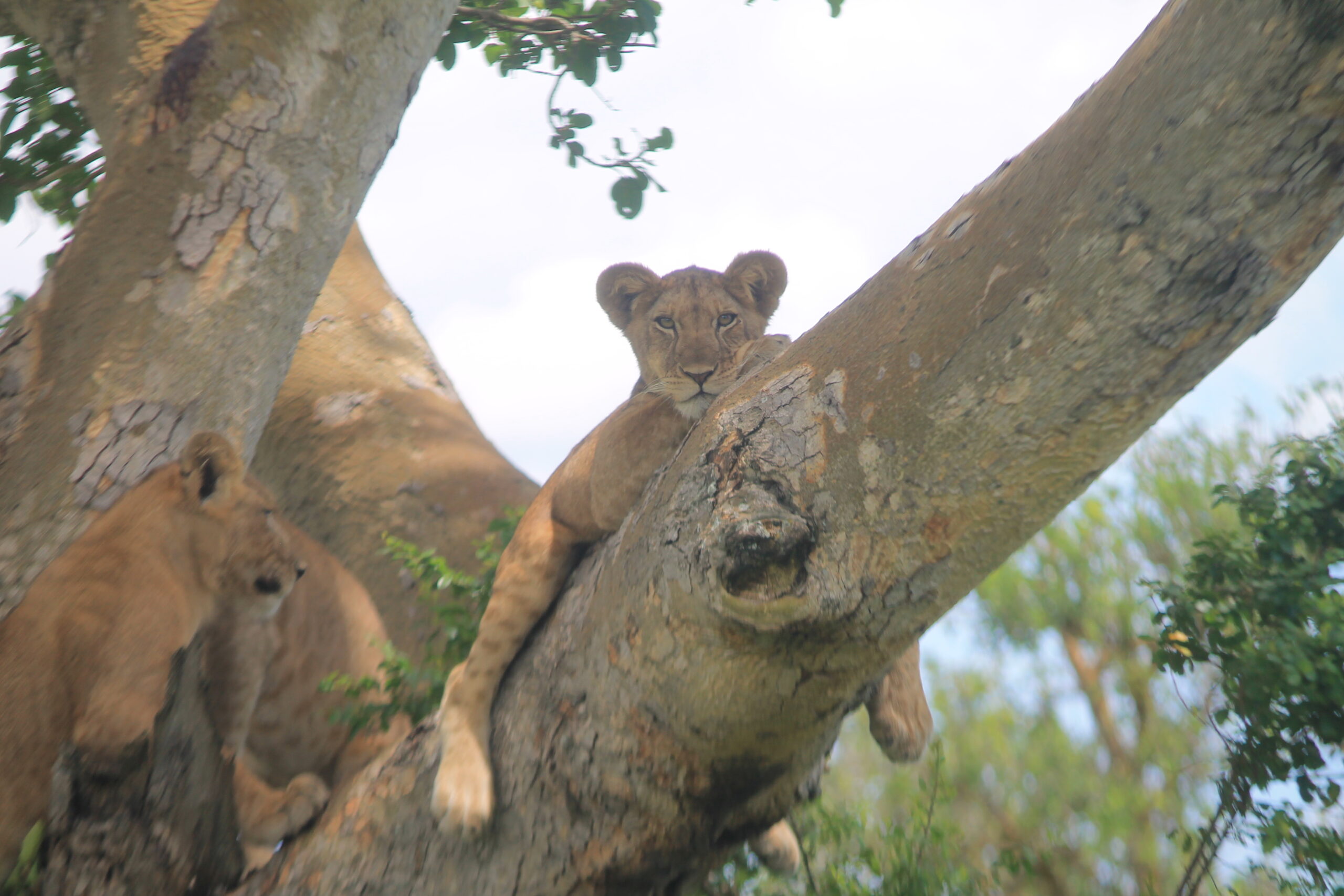Queen Elizabeth National Park
Queen Elizabeth National Park (QENP) is one of Uganda’s most frequented wildlife reserves, celebrated for its expansive savannahs, thick forests, crater lakes, and vibrant wetlands. This variety of habitats supports an exceptionally rich diversity of animals. With 95 mammal species—the highest count among Uganda’s parks—and over 600 bird species, QENP is a prime destination for nature lovers. Visitors can expect to see elephants, buffalo, and hippos, and may even spot lions, particularly in the Kasenyi and Ishasha areas. The park also offers breathtaking scenery, from the towering Rwenzori Mountains and volcanic hills to the grasslands of Kasenyi and Ishasha, the wildlife-rich Kazinga Channel, and the distant Mitumbe Mountains across the border in Congo.
When first established in 1952, the park was called Kazinga National Park, but it was renamed in 1954 to commemorate Queen Elizabeth II’s visit.
Activities & Attractions in Queen Elizabeth National Park
Mweya Peninsula and the Kazinga Channel
Mweya Peninsula serves as the primary tourism hub within the park, positioned 22 kilometers west of the Kasese-Mbarara Road. Perched on an elevated plateau with views over the Kazinga Channel and Lake Edward, this area features a luxury lodge, budget-friendly accommodations managed by the Uganda Wildlife Authority (UWA), a marina for boat excursions along the channel, and a Visitor Information Centre.
Launch Cruises
One of the most enjoyable ways to observe wildlife in Queen Elizabeth National Park is by taking a boat cruise along the Kazinga Channel. These two-hour round trips start from Mweya and travel to where the channel meets Lake Edward. During the journey, you’ll glide past riverbanks frequently visited by hippos, crocodiles, and a variety of waterbirds. Elephants, buffalo, and antelopes also often come to the water’s edge, providing excellent wildlife viewing opportunities.
Game Drives
Kasenyi Plains: The vast grasslands of Kasenyi are prime for wildlife watching, especially large herds of Uganda kob and the lions that prey on them. Skilled ranger guides often locate lions here, but for more assured sightings, visitors can join tours organized by the Uganda Predator Project, which monitors lions, leopards, and hyenas through radio tracking collars.
Ishasha: Located in the southern region of Queen Elizabeth National Park, Ishasha offers quintessential game viewing under the expansive rift valley skies. This area is home to buffalo, hippos, elephants, and topis. Ishasha is particularly famous for its unique tree-climbing lions, frequently spotted resting in the branches of fig trees.

Forest Walks
Kyambura Gorge: This lush, forested gorge extends from the Kichwamba Escarpment down to the Kazinga Channel. Visitors can take in breathtaking views from the rim of the 100-meter-deep gorge before descending with Uganda Wildlife Authority guides to track chimpanzees in their natural habitat.
Maramagambo Forest: Situated at the foot of the Kichwamba Escarpment, Maramagambo Forest provides a striking contrast to the park’s open savannas. Guided nature walks here offer chances to spot various primates and rare bird species, including the forest flycatcher, white-naped pigeon, and the vibrant Rwenzorituraco. The forest is also home to the Bat Cave, where visitors may encounter a python known for hunting bats.
Birding
Birdwatching is a favorite pastime in Queen Elizabeth National Park. The Kazinga Channel attracts a variety of resident and migratory waterbirds throughout the year. At certain seasons, visitors can observe large flocks of flamingos at Kyambura and Katwe soda lakes. In Maramagambo Forest, rare forest bird species may be spotted, and Lake Edward Flats in Ishasha offers excellent chances to see the elusive shoebill.
Volcanic Explosion Craters
Crater Drive: North of Mweya, numerous volcanic craters dot the landscape, serving as reminders of the Albertine Rift’s volcanic past. The 27-kilometer Crater Drive, stretching between Kabatoro and Crater gates, loops around these extinct craters, which now contain lakes, forests, and grasslands.
Katwe Salt Lake: Located 12 kilometers from Mweya, the town of Katwe has practiced salt extraction from Lake Katwe’s evaporation pans since the 14th century. Visitors can learn about this traditional process with local guides. Nearby Lake Munyanyange is also a haven for waterbirds, including lesser flamingos that migrate there from August to November.
Getting to Queen Elizabeth National Park
By Road
There are two main routes from Kampala to Mweya, the key tourism center of Queen Elizabeth National Park. The more scenic path, about 410 kilometers, goes through Fort Portal and allows for side trips to Kibale, Semuliki, and Rwenzori Mountains National Parks. The other route, approximately 420 kilometers, passes through Mbarara and Bushenyi and includes a stop at Lake Mburo National Park. The park’s southern Ishasha sector lies directly along the main road connecting to Buhoma, which is the primary gateway for mountain gorilla trekking in Bwindi Impenetrable National Park, located 62 kilometers to the south.
By Air
Charter flights can be arranged to several airstrips in the area, including Kasese, Mweya, and Ishasha.
